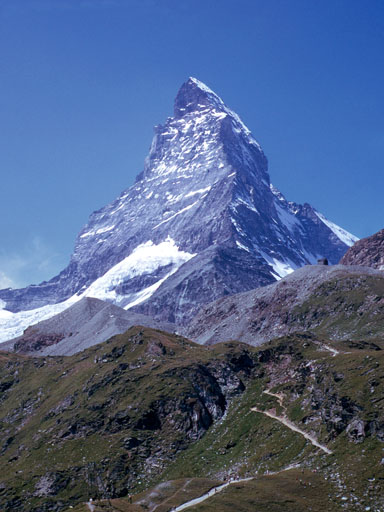Every night, do you understand, I see my comrades of the Matterhorn slipping on their backs,
their arms outstretched, one after the other, in perfect order at equal distances — Croz, the guide, first,
then Hadow, then Hudson, and lastly Douglas. Yes, I shall always see them.
– Edward Whymper |
The 14,690-foot Matterhorn in Switzerland |
Accept no substitutes. This is not just the extant Matterhorn, it is the extant mountain.
It is one of the best-known mountains in the world. |
 |
Welcome to the Swiss Alps
The unmistakable shape of the Matterhorn
The north face is the shadowed face on the right and the east face is the sunlit face on the left.
The Hornli Ridge, which is the standard route, is the sun-shadow ridge between these two faces.
It rises 4,000 feet above the hut at the base of the ridge. |
 |
A unique view of the upper part of the Hornli Ridge
This composite consists of several photos taken from a helicopter flying up the route
You can see many climbers, including Gerry who is the upppermost figure in the photo |
 |
The Swiss Summit of the Matterhorn seen from the Italian Summit. The Swiss Summit is the highpoint of the mountain. |
| Photos from the Gerry Roach Collection |
Rising on the Swiss-Italian border, the Matterhorn is steep on all sides, and none of its four major ridges offer
an obvious route. In particular, the steep north and east faces, which are seen from Zermatt, appear particularly
imposing, so early attempts shunned this side of the mountain. The race to climb the Matterhorn began in 1857,
when the brothers Jean-Jacques and Jean-Antoine Carrel made a serious attempt on the west ridge, but the steep ridge
quickly defeated them. The Carrels tried again the next year from the Italian side, but again didn’t get very high.
In 1860, the Carrels made it to 11,800 feet on the Italian side before an overhang stopped them. In 1861, the competition
keened when the English alpinist Edward Whymper made an unsuccessful attempt from the Italian side. Over the next two years
Whymper and the Carrels made numerous attempts, but they all fell short of the now most elusive of all alpine summits.
Then strangely, there were no attempts on the mountain in 1864. |
| In 1865, Whymper took a new look at the northeast ridge that separates the steep north and east faces. He reasoned that
the dipping rock strata, which produced overhangs on the west and south sides of the peak, should provide stair-step
platforms on the northeast side of the mountain. Whymper tried to convince the Carrels to join him on an attempt of
the northeast ridge, but the Carrels still favored the Italian side, and refused the offer. The Carrels planned their
own attempt, and when Whymper learned of this, he hurried to mount his own assault on the other side of the mountain.
The Carrels in a team of four, and Whymper with a large team of seven both started for the summit on July 13, 1865. |
| Whymper’s group camped at 11,000 feet, near the site of the modern-day Hornli Hut, then started toward the
summit early the next morning. Whymper’s analysis of the strata proved sage, the large team gained height quickly,
and reached the stupendous summit in the early afternoon of July 14, 1865, a moment that is embossed in time as the
end of the Golden Years of Alpine first ascents. Looking down the other side of the mountain, they saw the Carrel team,
and the Carrels, seeing Whymper on the summit, turned around. For the Carrels, second place was the same as last.
However, the large Whymper team still had to descend. |
| The steep terrain below the summit quickly tested the team, and they roped together as a string of seven so that
several climbers would always be in a secure position. Inching down, the guide Michel Croz had to help the inexperienced
Douglas Hadow by placing his feet into the holds. Then, the glory of their first ascent of the Matterhorn was forever
tainted when Hadow fell, knocking Croz off his awkward stance as well. The two men slid at first, arms outstretched
in an attempt to save themselves. Charles Hudson’s attempt to stop the fall failed, and he too started sliding.
Now with three men falling, Francis Douglas was yanked from his position. Whymper watched in horror as four of his
companions slid away from him. Later he wrote, “Every night, do you understand, I see my comrades of the
Matterhorn slipping on their backs, their arms outstretched, one after the other, in perfect order at equal distances
— Croz, the guide, first, then Hadow, then Hudson, and lastly Douglas. Yes, I shall always see them.” |
| Knowing that their own lives were now in grave peril, Whymper and the father-son team of Peter and Peter Taugwalder
braced for the inevitable impact. When it came, the rope broke. The falling four bounced and tumbled for 4,000 feet
while Whymper and the Taugwalders clung to their stance watching. They then went on to complete the descent,
only to face a storm of controversy. Thus began the modern age of Alpinism. |
| – Gerry Roach - From Ride The Breath |



